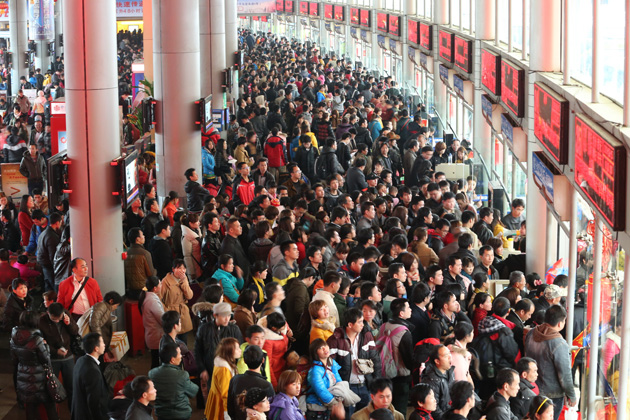With the Year of the Snake reaching its tail end, China has now officially entered Chunyun (春运)—the 40 day period of heavy travel that comes as many in the world’s most populous nation scramble home to welcome the lunar new year with family. This year’s Spring Festival travelers will be part of what could be a record-breaking example of the “world’s largest annual human migration.” The AP reports:
Authorities expect Chinese to make 3.6 billion trips during the 40-day Chinese New Year travel period that starts Thursday, officials said Tuesday.
These trips include intercity flights, trains and local bus rides to villages during China’s most important holiday, which is also known as Spring Festival. Each year, it represents the world’s largest seasonal migration of people as families reunite.
[…] Lian Weiliang, vice chairman of the National Development and Reform Commission, China’s top economic planning agency, said they expect 200 million more journeys than in 2013. [Source]
While the majority of Spring Festival commuters will be taking to the road (3.2 billion), a sizable portion of Chunyun participants will be traveling on China’s railway network, now under newly reorganized management following a massive corruption scandal in the now defunct Ministry of Railways. The New York Times’ Didi Kirsten Tatlow reports that all eyes are on rail in the as the mass migration begins:
Special attention is on the railway system this year, experiencing its first rush since its reorganization from a separate government ministry to a state-owned corporation in March 2013.
China Railway Corporation’s deputy general manager, Hu Yadong, said the corporation expected people to make 258 million rail journeys in the New Year period, China News Service reported, up 7.9 percent over last year.
[…] As for rail prices? They may not be raised to take advantage of people’s urgency to get home, Mr. Lian of the National Development and Reform Commission said, outlining a “Three No’s and One Investigate Policy,” meaning no deviating from state-set prices and investigations for any such deviations. [Source]
China Daily reports that the nation’s airlines are set to handle 42 million expected air trips:
[…] Xia Xinghua, deputy director of the Civil Aviation Administration of China, said at a news conference on Tuesday that Chinese airlines will provide at least 1.1 million seats every day to meet the travel peak.
The administration estimated that domestic flights will increase to more than 62,000 every week from the current 50,000, while international flights will increase 20 percent to more than 9,600 weekly.
Xia said the most popular destinations will be tourist cities like Sanya, Hainan province, and cities with large numbers of migrant workers, including Beijing, Shanghai and Guangzhou. Neighboring countries with many tourist attractions, like Thailand, South Korea and Malaysia, will also be popular during the spring rush, Xia added. [Source]
A major cause for annual increases in travel each lunar year is China’s growing population of migrant workers, itself a symptom of the country’s urban-rural economic imbalance. An article from the Global Times quotes an analyst who says that extended urbanization—a major policy objective under the Xi administration—is the first move towards lightening the Chunyun crowds:
Many analysts have noted while efficiency needs improving, the reason such hugenumbers are traveling at this time is due to an economic imbalance across the nation.
Zhao Jian, a professor at Beijing Jiaotong University, said to address the deep-rootedcause, it is critical to accelerate the urbanization drive and foster metropolitan clusters,in which urban areas spread out to the hinterland of larger cities.
“By relocating the migrants’ families to small and medium cities or towns on theoutskirts of large cities, this will largely ease the transport pressure,” Zhao said. [Source]
Another article from the Global Times looks briefly at one “unpopular argument”: that a changing China may be outgrowing the Spring Festival tradition:
There was a radical argument a couple of years ago that as a feature of China’s modernization has been mass migration, traditions like Spring Festival that require gatherings of the extended family no longer fit reality and thus need to be gradually discouraged.
Such arguments have been fiercely denounced online. No matter how globalization sweeps the world nowadays and how far people travel to live and work, every country still maintains a few indigenous festivals that allow family members to sit down, talk, eat and enjoy a rare moment under the same roof.
For Chinese people, in whose blood and bones is the cultural concept of “family,” the bitter chunyun is always tinted with the color of warmth.
Nonetheless, it seems that technological convenience and transportation network expansion are never able to catch up with the ever-increasing demand of China’s floating population. [Source]
As infrastructure is being reinforced and hundreds of millions of Chinese are preparing for travel, Chinese officials have been warned to remain frugal amid a central government crackdown on extravagance. From Bloomberg Businessweek:
China’s government officials are being warned not to get too festive during the upcoming holiday. China’s anticorruption agency, the Central Commission for Discipline Inspection, recently issued a notice encouraging whistle-blowing citizens and the media to report “exuberant spending and gift acceptance.” Under the austere headline, “Corrupt officials beware this new year,” Xinua reported:
“Around this period in past years, many officials have spent public funds on extravagant parties and banquets, and received or sent out cash gifts [and] shopping cards as well as fancy physical goods. Many have also attended dinners and other activities at high-end private clubs and recreational facilities at others’ invitations.” [Source]
Happy New Year, safe travels, and much patience to all of you traveling in China this holiday season. The following cartoon was drawn by netizen/cartoonist Mr. Stone (@二混子–Stone), retrieved by CDT Chinese, and translated by CDT’s Anne Henochowitz at the beginning of last years’ Chunyun.









